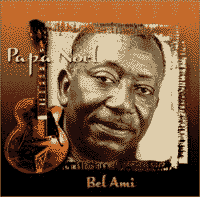
PAPA NOEL
BEL AMI (Stern's)
Papa Noel, currently reunited and touring with Sam Mangwana (from their Vox Africa days!), has a new release from Stern's call BEL AMI. It's actually a repackaging of most of his last two CDs: BON SAMARITAIN, recorded in Brazzaville in 1984 and HAUTE TENSION, recorded in Paris in 1994. Noel did most of the work himself by multi-tracking. For vocals he has Carlito Lassa and Wuta Mayi on the French session. The Stern's release provides a little more information on the earlier date: the great horn section is noted as "anonymous Congolese army band personnel." The sound is very much in the style of classic OK Jazz: seven minute trance-inducing workouts where (as my pal Zeca pointed out) time stands still. The guitar weaves in and out of the rhythm track with a rolling momentum. The arpeggiated runs of the mi-solo which flow so effortlessly from Papa Noel's hands come from a lifetime of practice.
As a teenager Noel backed Leon Bukasa and was drafted into the supreme team of Orchestre Rock-a-Mambo in 1960. After independence some members of the group, Noel and the two horn virtuosi Jean-Serge Essous and Nino Malapet, moved across the Congo river to Brazzaville and founded Les Bantous de la Capitale, a long-lived group that rivaled African Jazz and OK Jazz on the right bank. When Dr Nico left African Jazz to start his own band, Papa Noel was the only man capable of replacing him. His departure from Bantous required they find two guitarists to fill his shoes. But Noel was restless and enjoyed the challenge of new bands and different configurations. Finally he settled in as lead guitarist with Franco's OK Jazz and stayed for 17 years, until Franco's death in 1989, taking time off to record the BON SAMARITAIN album with OK Jazz bassist Makabi and drummer Pouéla Du Pool.
The debt to Franco is obvious in the sound of the band, though one wonders what Franco was doing with 18 sidemen when half a dozen can make as solid an album. The title track "Bel Ami" was called "Messager" on the Gefraco release. The first and last cuts of that album, "Selia Zozo" and "Sisi" have been omitted here, which is a pity as the entire album is worthy of reproducing. The HAUTE TENSION album was plagued with naff synthesizer and a programmed drum track. If you don't own BON SAMARITAIN (also known as Papa Noel NONO), get this and catch up with a classic.
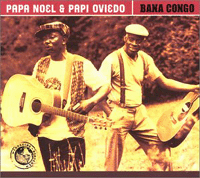
PAPA NOEL & PAPI OVIEDO
BANA CONGO (Tumi Music)
After the successful teaming of Senegalese singers and New York salseros in Africando comes a long-overdue collaboration: Cuban son and Congolese rumba. Papa Noel & Papi Oviedo's BANA CONGO is a beautiful blend of two very sympathetic musical styles. Reminiscent of Ricardo Lemvo's work, but leaning more to the acoustic side, this set sways back and forth from Congolese songs to Cuban ballads with Noel on acoustic guitar and some guest singers from Africa, backed by a top-flight band of Cubans with acoustic bass, bongo, congas, bata, and to sweeten it all, real brass! One of the great Congolese rumberos, Papa Noel was born on Christmas Day, 1940 (hence the nick-name). From his youth he learned to play Cuban songs on the guitar, copied off his mother's 78s and the music heard on Radio Congo Belge. He was part of the first great wave of Congolese bands: African Jazz, Rock-a-Mambo, Les Bantous de la Capitale, & OK Jazz. In fact he played in all of them! Papi Oviedo is the son of Isaac Oviedo, from whom he learned the tres. The tres is smaller than a guitar and has three sets of double strings, sounding higher and more jangly than a traditional guitar. Oviedo has plyed his art with Chocolate, Chappotin, Abelardo Barroso and Orquesta Revé (for 15 years). While Congolese rumba gave way to soukous, complete with drum machines and wanky synthesizers, Cuban music also suffered a blow as the harsher timba sounds replaced the sweeter older styles. Both men, Noel & Oviedo, now sexagenarians, have kept faithful to the classic styles and this album is a wonderful fusion of two very close musical genres. They alternate between Lingala, French and Spanish lyrics till they all seem to blend. In fact Papa Noel's beautiful ballad of lost love, "Juliana," reminds me a lot of "Yolanda" by Pablo Milanes.
The clave beat, so crucial to son, is held down with rock solidity (something I often find lacking in Congolese outings) but the parallel between the "montuno" and the "seben," where the song kicks into high gear (in both son and rumba), has never been particularly remarked and the band of Cubans follow Noel into the break of "Juliana" with gusto (and a roll on the congas). There's a variety of vocalists including Nana and Baniel from OK Jazz on backing chorus; Cristina Garcia sings her own "Limpia mi son" and Andres Sosa Revé sings his "Combinación de Soneros." These two tracks brought to mind the classic Barbarito Torres album HAVANA CAFE that I played continuously throughout 1999 and 2000. Nyboma comes aboard with his unmistakable falsetto for another sad love song by Noel, "Molimo," and manages to sound even more tentative and on the verge of cracking than the composer does on "Juliana." Another of the Quatre Etoiles, and former compañero of Noel in OK Jazz, Wuta Mayi, steps up for "Mbongé" which indeed reminded me of sixties Franco from the "Bella Epoca" when he was under the Cuban spell.
In retrospect this teaming seems so obvious, but it was a long time coming. The protagonists have put together a minor masterpiece.
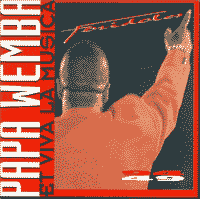
PAPA WEMBA
FOR IDOLES (Esperance CD 72424 1994)
In recent years the popular soukous formula from Zaire has grown increasingly tiresome as synthesizers replaced horns and programmation replaced live drummers, but it gets back to basics in this classic recording by the "Chief elder of the Rumba rock tribe." After touring with Peter Gabriel fronting a band of French wannabe rockstars, Wemba has reteamed with Viva La Musica for an album that is reflective without being retro. In songs like "Oldies are Goodies," Wemba demonstrates that with age comes wisdom. His near-falsetto soars over pealing guitar licks that reinvigorate Zairean dance music.
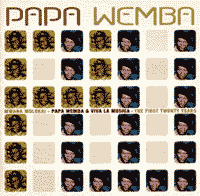
PAPA WEMBA & VIVA LA MUSICA
THE FIRST TWENTY YEARS (Stern's STCD 3019-20)
I don't think you could have found a bigger Papa Wemba fan in the 1980s than yours truly. I eagerly awaited his every release and, as my disillusionment slowly and reluctantly built, I kept buying his records in the hope he would see the light and get back to the great sound that he started from. This two-disc set from Stern's chronicles the highlights and decline of Wemba from the time he launched Viva la Musica until his last sad efforts with a surrogate band. But it was a great ride.
Wemba was a teenage rocker who, inspired by Los Nickelos and other new wave bands, formed Zaiko Langa Langa in 1969 and started a new trend in Congolese music: a stripped-down guitar band with no horns and half a dozen front men, variously singers & those who just shouted encouragement while looking sharp. Until Wemba left in 1974 it was one of the most prolific and influential bands in Congolese history. He was also fashion-conscious and started fads like colored berets that could easily be mimicked by impoverished youth in Kinshasa. His next band Isife Lokole was the bomb. Some of their 45s (that were compiled on LP by P-Vine in Japan) stay in rotation on my deck. Then he started a splinter group called Yoka Lokole. The underpinning of both these groups was folklore and they even included a traditional slit log drum -- the "Lokole"-- that is used for "talking" and sending messages in the bush. But in 1976 the band dumped Wemba unceremoniously. He put together a new group and, taking the name from a Johnny Pacheco album, launched Viva la Musica. Seemingly sloppy, the long unraveling songs are quite tightly arranged with a slow build up to a gradual release of energy and then about 7 minutes of outro jam which is where the dancers go nuts and the singers ad lib over increasingly complex guitar runs, while the bass and drums pummel the beat in barely controlled chaos. Every now and then Wemba reins it in for a beautifully sung chorus in his high falsetto and the guitarist, Bongo Wende, showers sparkling notes over the procedings like millions of lights reflected from a glitter ball.
Since the tracks are generally about 8 minutes long, it was a wise move to make this a double CD, but you have to settle in for a long listen. Despite being pop, there is a lot of tradition in these songs. Apart from borrowing from folklore, Wemba was a choir boy and loves the minor descant he learned in the church hymnal. His mother was a professional mourner and he also echoes some of her drawn-out lamentations when he gets morose. There is no doubt that Wemba was one of the most important African artist in the 80s. That he was largely ignored in the West is of no consequence: his style opened the door for Loketo, Matchatcha and all the Clan Langa Langa offshoots. Even the older bands like Quatre Etoiles changed their style to acommodate the new sound.
On the first disc we start with the first big hit, "Mère Superieure," which is indeed a gem. The sonic quality is a bit rough on these first selections, particularly on my favourite from this disc, "Analengo," which sounds like the single was pressed out of round: there is a lot of wobble to it and the vocals are over-miked, but still the energy is there and it reminds me of when I was totally in love with the VLM sound. But the 80s were not a good time to be a Wemba fan in the US. The Reagan and Bush administrations kept foreign artists from touring here. Wemba did finally come as opening act for Peter Gabriel at the Oakland Coliseum. I BARTed over there and bought a ticket from a scalper for $25. Wemba's show was pathetic: he was completely ignored by the fans who were hyped about seeing Gabriel so talked and milled about during his set. He had traded in Viva la Musica for some French rockers who were awful, and I barely recognised his sound. Gabriel came out and I stuck through a couple of numbers hoping to get something for my money, but I kept thinking about Wilhelm Reich's book, THE MASS PSYCHOLOGY OF FASCISM and how rockstars are dangerous figures to be in control of young minds, even someone as benign as Gabriel. The next Viva la Musica concert was to be a year later at Slim's in San Francisco, a perfect venue, and I hoped it would be the real band. However the show was canceled. What happened was the band showed up at SFO at 11 p.m. and called the club to say, Tell the opening act to keep going, we'll be there and ready to go on at 12. Don't bother, we decided you were not showing, replied the promoters.
All I had to sustain my interest was the video of LA VIE EST BELLE, the film starring Wemba as a down-and-out kid who makes it big as a singer in Kinshasa. Then in the mid 80s I was in Paris and there were posters everywhere advertising a big night with Viva la Musica, but as I got deeper into the African neighbourhoods I saw the posters had cancelation stickers glued over them. The music too began to depress me with its sameness. Every album had one good song but it was 75% filler. Then each member of the group, even the drummer, did a solo album using the name. I began to feel I was supporting a huge extended family with my weekly cash investments. When they started singing "Get up! Stand up!" in every song, I sat down. Eventually, I culled my collection down to the essential 22 LPs & 8 CDs. Here, for Stern's, Vincent Luttman has done the same on a bigger scale, and honed it down from an even bigger collection, including out-takes and singles I never got to hear, to two hours. It's probably all the Wemba you need. Actually it is better en masse than any single album, though I still have my favourites: the badly recorded AU JAPON, the fragmentary soundtrack to LA VIE EST BELLE, the weirdly atypical acoustic SIKU YA MUNGU. But the good news is there's enough here I don't know to make it enjoyable even to a hard-core collector like myself.
The second disc starts with the downfall: his first record with Hector Zazou and the unmistakable 144-BMP bomp of a drum machine (the dreaded Doctor Rhythm) with some wobbly synth crap making like an autoharp in the background. Much as I loved Wemba and played him regularly on my radio show, I never thought of him having "hits" per se, but now listening to this disc I realise that his song "L'Esclave" is indeed one of the great hits of African music from the 1980s, and it's great to hear it again from some distance. First of all it's a song about slavery, something Africans don't discuss much in case they are accused of complicity. Second, it's a beautiful melody with the guitar perfectly complementing Wemba's scorching vocal. Soon after, Wemba was discovered by a wider audience via WOMAD and gradually his sound softened as synthesized strings and acoustic guitar were brought up in the mix. Conseqently his nineties' music is tame and now really does sound like disposable pop pap. The Gabriel connection (which is skipped over in this compilation) led to a lame album on RealWorld in which he covered Otis Redding's "Fa-fa-fa-fa-fa-fa": not a wise idea. Too many sycopha-pha-phants telling him he was the new Otis got to his head. Good as he may be, Wemba is not the new Otis. He is however an original and talented singer. Wemba may still come back and surprise us all with a great album, but I won't be the first to buy it.
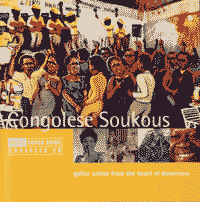
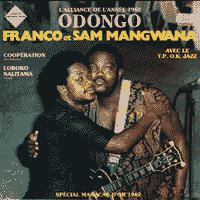
VARIOUS ARTISTS
THE ROUGH GUIDE TO CONGOLESE SOUKOUS (Rough GuideRGNET CD)
Graeme Ewens, who wrote the biography of Franco CONGO COLOSSUS, compiled this Rough Guide CD, and has included a wide spectrum of styles under the soubriquet of soukous. THE ROUGH GUIDE TO CONGOLESE SOUKOUS is anything but rough. It starts with a major bombshell: Sam Mangwana's incendiary duet with Franco on "Cooperation," a 1982 dance groove that signaled Sam's return to the fold (it's also known as "Odongo"). Sam had the nerve to walk out on OK Jazz and went to Abidjan to pursue a solo career. When he came back to Franco he was given star billing and a new car. The landmark opening cut fades at 10 and a half minutes so if this gets to you, you'll have to seek out the CD reissues. (Sonodisc with typical crassness split the original album up and put the four tracks on two different CDs; Popular African Music, the superb German label, also put out a Sam Mangwana LP called CANTA MOZAMBIQUE that included two out-takes from the same sessions, minus Franco.) Wherever you find it, this super-session is at the heart of Congolese music.
Koffi Olomide always has great backing bands, though he's considered a tyrant by many musicians who quickly leave him. I am not enamored of his deep reverb-laden voice (he talks more than sings and sounds like a diminutive Pepe Kalle) and the track here doesn't move me. Kanda Bongo Man, too, is better live than on record, but Ewens has included these lesser luminaries up front. K.B. Man also has stellar sidemen and many renowned Congolese guitarists, like Diblo Dibala and Rigo Star, came through his band. But the kwassa kwassa here on "Loi" sounds thin and very dated. Kanda himself started out with the legendary Orchestra Bella Bella which also nurtured Nyboma and Shaba Kahamba. They should be on this compilation, so should Lutchiana Mobulu, Felix Wazekwa, Madilu System, Josky & Ntesa Dalenist, or at the very least Quatres Etoiles, Loketo, Arlus Mabele, and a Bella Bella or Empire Bakuba track instead of two by Zaiko Langa Langa. In fact there could easily be another CD that takes a different tack from this one.
Compiler Ewens also has a record label -- RetroAfric -- and he leased two of his own tracks for the compilation: Ryco-Jazz's "Marie Jose" (I would rather have had the original "Merengue Scoobidoo" by Dr Nico that this is based on, or one of their recent dance smashes like "Desarmement") and an obscurity, Thu Zaina.
Deyess Mukangi is included in a lightweight entry. I guess you had to be there & see her perform in all her glamourosity. I can think of two other Congolese women singers that would have been stronger entries: Tshala Muana and M'Bilia Bel. The Pepe Kalle and Rigo Star duo gives new meaning to the term "generic soukous." It's not surprising that it's taken from an album called FORMULA ONE. But Ewens is being sneaky because right after that formulaic nonsense he throws the neglected gem by Thu Zaina at us: "Sanga Mbele Mbele." This is the type of music that broke away from the big horn ensembles and put the snare drum up front. You get the sense that hysteria is about to break out on the dancefloor when they get in gear.
Tabu Ley Rochereau is here at his slow-burning peak from 1980 (when everything was copacetic with M'bilia Bel) with the sweat-drenched "slow" track "Sarah" -- it's a timeless moment that defined a whole era of Congolese music, with the sweetly humming flanged guitars, the squeaky sax and the relaxed bass drum bomp casually clocking the beat.
Frenzy returns for the cut by Nouvelle Generation, "Ma Cherie." I actually got rid of this album when I was purging all the crappy synthesizer music from my collection, but, apart from the sound effects of a car crash at the end, it's a catchy number. The final track has crappy synth, bad rapping & formulaic guitar as if to demonstrate the sorry state that soukous arrived at in its development. If your shelves aren't saturated with soukous, this compilation has a few interesting tracks. It's by no means definitive or thorough, but it is characteristic, and a great way to get the party going.
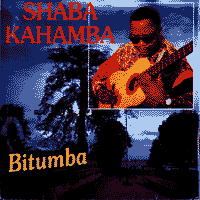
SHABA KAHAMBA
BITUMBA (KARAC CD 444 50)
You can't wear out CDs, but if you play them enough people will "borrow" them from you at parties and forget to return them. I has heartbroken when my copy of BITUMBA waltzed off. Then I found it on vinyl and was ecstatic. (More musical real estate!)
Once a member of the pre-soukous Zairean dance band Orchestre Bella Bella, Shaba Kahamba played bass guitar on tour with Kanda Bongo Man. Here, backed by Les Esprits Saints, a house band assembled by the great Antillean arranger Eddy Gustave, he shows that old-timers can still rock. No drum machines fake the tempo; the mix even includes acoustic guitar and good horn arrangements instead of the cheesy French synthesizer spread that's on so much African dance product. Uncredited horns are Eddy Gustav's department; the guest guitarists are Huit Kilos (ex-Rochereau, now with Ricardo Lemvo's Makina Loca), and Caien Madoka. The CD has only 6 tracks but has "party" writ large on it.
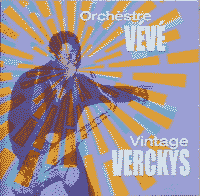
VERCKYS
VINTAGE VERCKYS (RetroAfric)
While I've been lamenting the dearth of anything new and exciting from Africa, there are always classic reissues, many of them of previously hard-to-find or even totally unknown artists. One such offering jumps into the CD player and refuses to budge. RETROAFRIC in their calm methodical manner have now notched up 15 titles in their series of classic African oldies. VINTAGE VERCKYS is a bulls-eye as well as a long-overdue tribute to a man I think of as the Lee Perry of Africa (in that he is unique, an important producer, and totally insane -- in the nicest sense).
Kiamungana Verckys' musical career started as a youth playing sax in a church fanfare band. Soon he discovered King Curtis and began honking out his own version of the gutbucket style of American soul and R&B saxophony. At 20 he was recruited to OK Jazz to play second sax to Isaac Musekiwa and soon became Franco's right-hand man. As the liner notes (unsigned, but probably by Graeme Ewens) say, "For the next few years he brought some raucous excitement to the OK Jazz repertoire with his modern interpretation of Kongo folklore rhythms and provided visual entertainment with his hippie clothing and frenetic dance routines." While Franco was away touring Europe, Verckys took the core of the band into the studio and cut several of his own sides. Franco demanded a percentage so Verckys went solo and set up his own Orchestre Vévé. The appeal of Vévé is in the sebene where you normally have an electric guitar solo, but now you get a sax improvisation. His popular cavacha dance was a direct precursor of soukous. Verckys was also a successful talent scout and producer and built an important label (You can often spot a Verckys band by the doubling of the name: Bella Bella, Lipua Lipua). Among his biggest successes were Empire Bakuba and Les Grand Maquisards and the next generation beginning with the Langa Langa clan. In that later sound, however, the saxophone was sadly eliminated.
Several of my favorite Verckys tracks are included here: "Baluti," "Mama Djele," and "Bilobela." Most of the others are new to me. Amazingly there's no "Mfumbwa," -- a Mombeta rhythm which was a huge hit in West Africa; also no "Nakomitunaka," an exquisite ballad which asks "Why are all the statues in the church white?" I guess they'll be on volume 2.
These tracks are undated but undoubtedly come from the late sixties and early seventies when Congolese music was in flood. Singers were trying to relate to James Brown through grunting and exhorting the musicians but English was an alien language to them while Johnny Halliday no longer seemed relevant. There's a restraint bordering on nervousness in the guitar mi-solo just hanging back behind the vocals waiting for the bridge to kick into high gear, over-miked acoustic bass, skittering percussion, close harmonies and Verckys' wild honking sax sounding like he's using a very frayed reed. But the overall sound is assured and relaxed. You can imagine the crowd grooving to this on a hot night at the Vis-à-Vis club, and most of the tracks follow the A-side B-side formula clocking in at ten minutes. The sound is raw in places, but the music has a sophistication for all its earnest innocence and speaks directly to the heart of the Congolese joie de vivre.
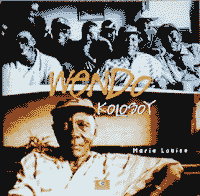
WENDO KOLOSOY
MARIE LOUISE (Label Bleu/Indigo)
My big love in the early 90s was soukous but as far as I can tell that is as dead as the dodo. Wendo Kolosoy's MARIE LOUISE is a loving flashback to the Congolese rumba roots of that once-dominant sound. Wendo Kolosoy was one of the fathers of modern Congolese rumba. His song "Marie Louise" was one of the first big hits on the Ngoma label back in 1948. Now over half a century later he has assembled a young band with an acoustic line-up that replicates the relaxed sound of the fifties: upright bass, congas, acoustic guitar, spoon on beer-bottle percussion. The whole thing is light and beautifully recorded. Wendo's voice is cracked and he yodels a bit but it's charming and very catchy. During the MASA Festival in Abidjan he recorded an album of new and old material. The solo guitar work of Vula Missy and mi-solo of Camerounian Zacharie Onana is exceptional. They opens with a memorial tribute to Pepe Kalle: it's very emotional and you sense Wendo is really singing to all those who have gone before, including Pepe Kalle's mentor Joseph Kabaselle ("Le grand Kalle") and members of African Jazz. (I played a favorite rumba by that band for Tabu Ley Rochereau once and he looked at me wistfully and said, "Ah, all of zem dead.") But Wendo is kicking and his band are in the groove, and it's fun spotting the quotes from old songs in the instrumentation and chorus. The album ends with an extended jam on the outro to "Maria Tebbo," a song that was a huge hit twenty years later for Sam Mangwana. One of the concert highlights of 2000 was hearing Sam do that same outro with his band, including Papa Noel and Syran Mbenza, at Ashkenaz, a small club in Berkeley. But Wendo proves yet again, the old roman maxim, "Ex Africa semper aliquid novii."
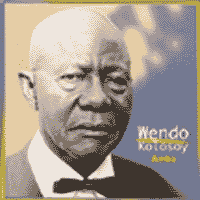
WENDO KOLOSOY & VICTORIA BAKOLO MIZIKI
AMBA (World Village/ Harmonia Mundi)
Wendo Kolosoy (now confusingly referred to as Papa Wendo) was one of the first big stars of Congolese music with his hit "Marie Louise" in 1948. He retired from music during the Mobutu era (thirty years of slow disintegration in the country, brought to you by the CIA, leading to chaos). He returned in 1993 and now has started touring with a line-up that recalls the formations of his youth: two guitars, bass, congas, horns. As I am passionate about African Jazz, Rock-a-Mambo, African Fiesta and bands of that era, it's great to hear the sound is alive and thriving. Of course many bands like Soukous Stars and Soukous Vibration scored hits with updated versions of Congolese oldies, but they put them in a disco context, whereas they work best in the acoustic arena with trumpet and sax instead of synth. Wendo yodels and croaks a bit, but that's his style. Most of the songs are slow rumbas. There is a Swahili song in 6/8 time, but mostly the tempo is laid back. This doesn't prevent the band from rocking out, as they do on the opening cut and the title track "Amba." Another old-timer, Antoine Mundanda, pops in (by helicopter from the bush apparently) to accompany Wendo on thumb-piano for a spot of spontaneous improvisation. It seems to be a song about their years spent in the two capitals across the Congo river, Kinshasa and Brazzaville. (Lingala is a tantalizing language because there's enough French in it that you can sort of follow what they are saying.) "Marie-Marie" is another love song from the early days of Wendo's career. The band anatomize it carefully, adding great guitar and conga fills like extra voices. This version, at 6 and a half minutes, doubles the length from the early recording and also from a recording made with Dizzy Mandjeku in 1993. Wendo's band comprises younger musicians and some stalwarts of the scene who played with Bella Bella (guitarist Vula Missy), Afrisa of Rochereau (trumpeter Biolo Batilangandi), and even African Jazz (saxophonist Munange Joseph). The rhythm guitarist and backing singers were part of Wendo's original band, Victoria Kin. Victoria Bakolo Miziki are very accomplished and, like Guinea's Bembeya Jazz, are keeping a historic style alive while investing it with new vigour.
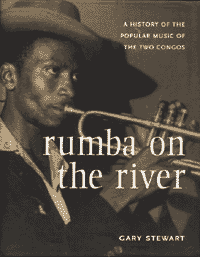
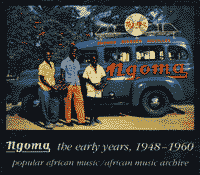
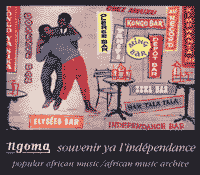
BOOK REVIEW
GARY STEWART
RUMBA ON THE RIVER
(VERSO 2000 436 pp, cloth in dj)Gary Stewart's RUMBA ON THE RIVER, subtitled "a history of the popular music of the two Congos," comes from Verso editions. It's a beautifully designed book, although it could have used better photos, but I am not complaining: this is the first really detailed study of the birth of modern Congolese music, from the Second World War (a period coinciding with the first large radio transmitters which could reach all of Africa, and led to the musical dominance of the Congo sound) to today. Putting the music in a cultural context, with politics, race and social progress all playing a part, Stewart has produced a truly valuable document that finally straightens out all the facts about the various studios in Leopoldville and Stanleyville -- Ngoma, Opika, Loningisa, etc. -- that gave birth to the sound and the fluid mix of musicians that made up the various house bands and led to African Jazz, OK Jazz, Rock-a-Mambo, the Bantous de la Capitale and others.
While there is no CD specifically to accompany the book, anyone interested in the music will want to find the ROOTS OF RUMBA ROCK CDs (craw 4, and craw 10 from Crammed World), BANKOLO MIZIKI ("Les pionniers de la musique congolaise de Leopoldville à Kinshasa") (Ngoyarto NG 047, NG 048) and the two Ngoma compilations from Popular African Music: NGOMA: THE EARLY YEARS, 1948-60 and NGOMA: SOUVENIR YA L'INDEPENDENCE (pamap 102 and 102), as well as the MERVEILLES DU PASSÉ series (3 volumes, and 12 volumes of COMPILATIONS MUSIQUE CONGOLO-ZAIROIS) on Sonodisc (currently out of print). For specific bands, the book includes a discography, but a basic collection would include Grand Kalle & L'African Jazz SUCCÈS DES ANNÉES 50/60 (2 vols, Sonodisc 36560, 36561), Bantous de la Capitale LA BELLE EPOQUE VOL 1 (Glenn Classics GM 324001) and Franco & OK Jazz ORIGINALITÉ (Retro 2XCD) which has been remastered for the 1999 reissue.
If you are interested in African Music, even slightly, this book will inspire you. If you are already a fan you doubtless have it & browse it regularly.